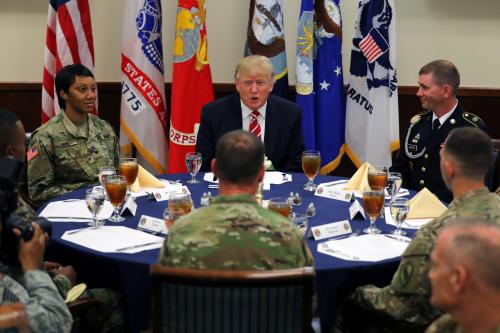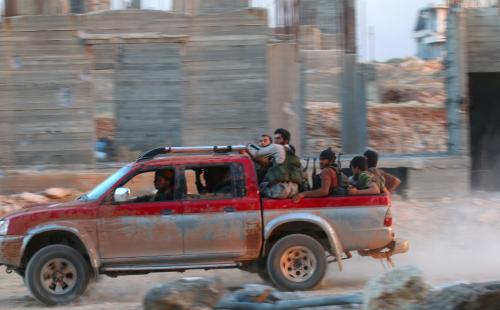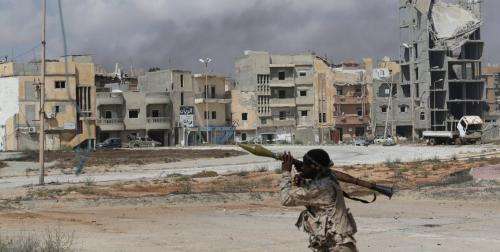Daniel Byman testified before the Senate Committee on Foreign Relations regarding the geographic scope of ISIS to inspire lone wolves and conduct terror attacks in Europe and around the globe. Watch the recording of the hearing here.
Chairman Corker, Ranking Member Cardin, members of this distinguished committee, and committee staff, thank you for the opportunity to testify.
The terrorism threat posed by the Islamic State is real but at times exaggerated and even more frequently misunderstood. From the Islamic State’s peak in 2015, the group suffered numerous setbacks, losing much of its territory in Syria and Iraq while most of its so-called “provinces” elsewhere in the Muslim world also lost territory or stagnated. The Islamic State, however, has demonstrated the capability to launch a range of deadly terrorist attacks in Europe, Asia, and elsewhere, some orchestrated by the group’s senior leaders and others carried out by low-level supporters. “Lone Wolves,” individuals embracing the Islamic State’s call for violence but largely acting alone, have also attacked the United States. Fortunately, the United States has proven less vulnerable than many of its allies due to its geographic distance from the conflict, the small number of Americans who sympathize with the group, an American-Muslim community that works well with law enforcement, disruption of the Islamic State’s infrastructure abroad, and aggressive security service action at home. Nevertheless, we should expect at least some level of jihadist terrorism against the United States and especially Europe in the years to come.
The Islamic State poses a direct danger to U.S. interests in the Middle East. The Islamic State has made a home in warring or ungoverned areas of the greater Middle East, exploiting conflict and weak governance in Afghanistan, Egypt, Libya, and elsewhere. The Islamic State and other jihadist groups feed on civil wars, making them more brutal, more deadly, and harder to resolve. These wars and their associated terrorism further decrease stability in the Middle East, posing a threat to regional U.S. allies and U.S. interests.
Although U.S.-led advances against the Islamic State’s base in Iraq and Syria will likely continue, the United States is not fully prepared for the group’s defeat. After losing control of key territory, the Islamic State may repeat its previous actions when the U.S.-led surge brought its predecessor organization in Iraq to the edge of defeat: go underground, disrupt politics in these countries, wage an insurgency, and then come roaring back. Current local allies in Iraq and Syria are unprepared to govern and conduct effective counterinsurgency operations, while the very identity of long-term U.S. allies are unclear as Washington lacks a durable coalition in Iraq, let alone in Syria. Nor are American regional or Western allies prepared for the likely diaspora of returning foreign fighters.
President Donald J. Trump has continued several positive counterterrorism policies but also undertaken initiatives that risk aggravating the terrorism problem. The administration has improved relations with important allies like Saudi Arabia and continued the military campaign that began under former President Barack Obama, which is steadily driving the Islamic State from its strongholds in Iraq and Syria. However, the administration’s anti-Muslim rhetoric and policies will likely alienate some American Muslims, increasing the risk of radicalization and discouraging cooperation between these communities and police and intelligence services. In addition, the administration’s blanket embrace of the Saudi position in the Middle East will heighten sectarianism, which feeds the Islamic State. Finally, declines in foreign aid, the State Department budget, and national security personnel diminish U.S. diplomacy and the United States’ ability to resolve conflicts, which are necessary for fighting the Islamic State and preventing it from spreading to new areas.
The remainder of my statement has three sections. I first provide an overview of the Islamic State threat and why I judge the danger to the U.S. homeland to be real but manageable but the danger to be Europe and especially the Middle East far greater. Second, I describe several problems that I believe will likely manifest in the current administration’s unfolding counterterrorism policy. In the third section, I offer recommendations for U.S. counterterrorism policy.
Understanding the Threat
The Islamic State poses a real but manageable threat to the U.S. homeland. Since the September 11th attacks, 95 Americans have died in jihadist-related attacks in the United States. The two deadliest attacks, in San Bernardino in 2015 and in Orlando in 2016, which together killed 63 Americans, involved individuals who claimed some allegiance to the Islamic State but acted independently of the group—often referred to as “Lone Wolves.”
Although any death from terrorism is unacceptable, it is worth noting several positive aspects of these numbers. First, the number of deaths—95—is far lower than many experts, both inside and outside of government, predicted. Second, the individuals involved in both the Orlando and San Bernardino attacks did not travel abroad to fight with the Islamic State, were not controlled by Islamic State leaders, and their violence seemed to mix personal and psychological issues with traditional terrorism, suggesting they might have embraced violence for other reasons had the Islamic State not existed. Third, although their targets—a workplace holiday party in a community center and a gay nightclub—show they might strike anywhere, they are hardly the high-profile, well-guarded targets that gained Al Qaeda popularity. Fourth, deaths from terrorism and terrorist plots on the U.S. homeland in the post-9/11 era are often below levels for the pre-9/11 era.
Multiple factors likely explain this relatively low level of violence. First, senior U.S. officials overestimated the number of radicals in the United States after 9/11 when they spoke of thousands of Al Qaeda terrorists in the United States.1 Second, the American Muslim community regularly works with law enforcement, leading to many arrests. As former FBI Director James Comey explained, “They do not want people committing violence, either in their community or in the name of their faith, and so some of our most productive relationships are with people who see things and tell us things who happen to be Muslim.”2 Almost half of all tips on potential extremist individuals come from the American Muslim community.3 (Indeed, a member of the local Muslim community reported the Pulse nightclub shooter to the FBI before the attack.) Additionally, U.S. efforts abroad, notably targeting terrorist leaders in their sanctuaries, exacerbates the leaders’ ability to organize, train, and plot attacks, particularly “spectaculars” that require years to plan and orchestrate. This disruption also hinders the group from accessing the United States. Finally, the massive increase in funding and aggressiveness of the FBI and foreign-oriented intelligence agencies enabled a broader effort to disrupt potential attackers, foreign fighters, and other radicals. Global intelligence cooperation in particular resulted in the identification and disruption of numerous potential terrorist plots. Similarly, the FBI’s efforts at home, while at times leading to arrests of individuals who had little or no chance of conducting an attack, led to the early disruption of some plots that might have killed many people.
Europe presents a grimmer situation, however, as demonstrated by recent attacks in London, Manchester, Nice, Paris, and elsewhere. In Europe, there are more radicalized Muslims relative to their overall population, as suggested by the dramatically higher number of foreign fighters from European states relative to their populations. Indeed, if we were to count only European Muslims as citizens (i.e. to focus on the relative percentage of Muslims radicalized), Europe would have a higher number of foreign fighters in Syria per capita than any Arab country.4 In addition, many European Muslims integrate poorly into their broader communities, which discourages them from cooperating with intelligence and law enforcement services. Furthermore, jihadis and returning foreign fighters from Iraq and Syria can more easily travel to Europe than the United States based on distance alone. Finally, European intelligence services vary in skill: some, including France and the United Kingdom, are highly skilled while others, such as Belgium, are under-resourced and less capable of responding to terrorism threats.
Even in Europe, however, the situation is often less dire than commonly portrayed. Europe experienced considerable acts of terrorism in the pre-9/11 era. By most analyses, the European terrorism problem in the 1970s and 1980s was significantly worse than it is today. State sponsors like Iran and Libya, nationalist groups like the Provisional Irish Republican Army and Basque separatists, and left-wing groups like Greece’s November 17 all carried out numerous attacks that killed hundreds of Europeans. Indeed, the biggest terrorist attack in the modern era in Europe occurred in the pre-9/11 era: the bombing of Pan Am 103 over Lockerbie, Scotland in 1988 that killed 270 people.5
The Islamic State, Al Qaeda, and the broader jihadist movement pose a yet bigger threat in the Middle East. These groups did not cause the civil wars in Iraq, Libya, Syria, and Yemen, but they have exacerbated them, transforming local struggles based on parochial grievances to wars with a strong jihadist component. In addition, the Islamic State introduced especially bloody and horrific tactics, such as beheadings, and enforced a grim and brutal interpretation of Islamic law in areas that they control. Furthermore, the group uses massive amounts of terrorist-type tactics in war: they claimed over 100 suicide attacks in Iraq and Syria in May 2017 alone. The Islamic State’s horrific violence complicates negotiations as they are not an acceptable voice at the negotiating table yet remain a force on the ground. In addition, they further complicate negotiations by trying to regionalize or internationalize local conflicts. For example, the Islamic State’s province in Gaza downed a Russian airplane in 2015, and the central Islamic State reportedly carried out terrorist attacks in Turkey, Saudi Arabia, Jordan, and Lebanon. In addition to being deadly, these attacks often degrade politics in these countries, lead to additional meddling in the Syria conflict, or otherwise worsen regional stability and hurt U.S. interests in the region.
The Islamic State’s loss of territory in Iraq and Syria has dramatic implications for the terrorism threat. In the long-term, this loss of ground is good news and will deprive it of a haven in which to recruit, organize, and plan attacks. In addition, part of the group’s appeal was that it successfully defied the world to “create” a true Islamic State—claims that are now easy to refute. Not surprisingly, the number of foreign volunteers joining the group plummeted in the last year, and its budget, which relies heavily on “taxing” local territory, also declined.6
This loss of territory and resources, however, increases the Islamic State’s desire to conduct international terrorism. The group has long prioritized creating, maintaining, and expanding an Islamic State; but as this goal becomes impossible, it will require high-profile actions to stay relevant. International terrorism offers a means to strike its enemies and prove to potential supporters that the group remains active and deserves their backing. Thus, it is unsurprising that the group has conducted more international attacks as it has suffered setbacks and shifted from urging its followers to act at home instead of traveling to Syria. This pattern may also apply to its so-called provinces that might focus internationally as their local ambitions fail.
Increased “Lone Wolf” attacks are particularly likely. The trend towards “Lone Wolf” attacks has grown: although the absolute number of attacks remain low, the scholar Ramon Spaaij found that the number of “Lone Wolf” attacks since the 1970s grew nearly 50 percent in the United States and by more than 400 percent in the other countries he surveyed.7 The Internet and social media explain part of this increase as both aid the Islamic State in inspiring individuals to act in its name. In addition, as New York Times reporter Rukmini Callimachi discovered, the Islamic State used social media to provide at least limited guidance to many attackers overseas, bridging the historic gap between a top-down orchestrated attack and a “Lone Wolf” strike.8 Finally, would-be fighters who do not travel pose a danger: according to one 2015 study of the terrorist plots in the United States, 28 percent of returned foreign fighters participated in a plot, but a staggering 60 percent of those who considered but did not attempt to travel became involved in a terrorist plot.9
Although the Orlando attack suggests that “Lone Wolf” attacks can be bloody, most “Lone Wolves” are incompetent; they are unlikely to succeed compared to attacks by trained foreign fighters who return to their home countries.10 But “Lone Wolves” have a strategic impact by altering politics in the United States and Europe, thus shattering relations between Muslim and non-Muslim communities so vital to counterterrorism and to democracy itself. “Lone Wolf” attacks increase Islamophobia in the West. After attacks in Paris and San Bernardino, concerns about terrorism spiked.11 In the weeks following the Paris attacks in November 2015, London’s Metropolitan Police Service announced that attacks targeting Muslims had tripled.12 Meanwhile in the United States, assaults against Muslims have increased to nearly 9/11 era levels according to analysis by the Pew Research Center based on FBI crime statistics.13
This Islamophobia also can begin a dangerous circle. As communities become suspect, they withdraw into themselves and become less trustful of law enforcement, which results in providing fewer tips. In contrast, if a community has good relations with the police and society, fewer grievances exist for terrorists to exploit and the community is more likely to point out malefactors in their midst. Even though he was never arrested, the attacker in Orlando came to the FBI’s attention because a local Muslim was concerned by his behavior and reported him.14
Such problems risk fundamental changes in politics and undermine liberal democracy. Far-right movements are growing stronger in several European countries. In the United States, Islamophobia and fears of terrorism—despite the lower level of attacks on U.S. soil than anticipated since the 9/11 attacks—have fueled the rise of anti-immigrant politics.
Assessing Changes in the Trump Administration
In several important areas, the Trump administration continued the policies of its predecessors. The administration has continued the military campaign against Islamic State forces in Iraq and Syria, although it appears to have slightly loosened restrictions on military commanders and deployed additional forces to Syria, nearly doubling the number of previous forces in the fight for Raqqa.15 Additionally, it maintained the coalition of states and local actors that the Obama administration cobbled together. Furthermore, the aggressive global intelligence campaign begun under President George W. Bush and continued under Obama remains robust. Together such efforts have hindered Islamic State operations and steadily shrunk its territory. In addition, the group’s various provinces have failed to expand and suffered significant blows, as in the case of its most successful province in Libya.
In his first few months in office, however, the President has taken several steps that may impede the struggle against jihadist terrorism. First, in his campaign rhetoric and through actions like Executive Order 13769 (the so-called “Muslim ban”), the Trump administration is demonizing American Muslims and damaging relations between religious communities—a traditional source of American strength, pride, and values. Such actions increase the allure of the Islamic State and other groups that claim that the West is at war with Islam. In addition, these actions increase the likelihood that Muslim communities will fear the police, FBI, and other government institutions, and thus be less likely to cooperate with them.
Overseas, President Trump embraced the Saudi perspective on the Middle East. Saudi Arabia is an important counterterrorism partner, and the United States shares several vital interests with the Saudi regime. Relations with the Kingdom became strained under Obama, and President Trump’s efforts to strengthen ties should be commended. However, the Saudi government continues to fund an array of preachers and institutions that promulgate an extreme version of Islam, enabling the Islamic State to recruit and otherwise gain support. In addition, Saudi Arabia promotes an anti-Shi’a agenda that harms regional stability and fosters sectarianism, a key recruiting tool of the Islamic State. More broadly, the disdain for human rights as a foreign policy value adopted by the administration advances the argument that the United States cares little about the well-being of ordinary Muslims and is uncritically on the side of the dictatorial regimes in the Arab world.16
At home, administration officials appear highly skeptical of programs to counter violent extremism (CVE). Many such programs are based on weak data and untested theories and demand scrutiny and oversight.17 However, many of these programs deserve continued support because they offer an often cheap and valuable tool to work with communities and could identify and stop potential terrorists. In addition, the administration proposed dramatic cuts to the already-small foreign aid budget and has not staffed the Department of State, the civilian arm of the Department of Defense, and other key agencies. As a result, the U.S. ability to use a whole-of-government approach to combat terrorism is diminished.
Initial signs suggest that the Trump administration would respond poorly to a terrorist attack on U.S. soil. At a time when a president should provide steady leadership, President Trump’s record suggests he might speak or tweet too quickly, without assembling the necessary facts or listening to the views of his advisors. His response to the London attacks earlier in June needlessly aggravated U.S.-U.K. relations at a time when allies should come together. The President has lost credibility among many Americans, which will cause the public to be skeptical of his claims on the nature of any terrorist attack and necessary subsequent actions in the aftermath of an attack.18 He may seek broad detentions or surveillance or act otherwise in ways that might exacerbate the problem in the long-term. After 9/11, the United States detained over one thousand Muslims, gaining almost no useful intelligence but harming relations with the community. As Daniel Benjamin, a former senior counterterrorism official, recalled, “Repairing the damage from that crackdown took years.”19
Recommendations for Better Fighting the Islamic State
One of the biggest challenges for the United States is preparing for the military defeat of the Islamic State. The Islamic State is preparing to go underground and wage an insurgency, but it will nevertheless be diminished in both stature and capabilities. Instead of relaxing pressure, the United States must redouble its efforts. This will require crafting a sustainable coalition of local allies in Iraq and Syria that demands resources, skill, and high-level engagement.
I have long advocated training allied forces, but this must be understood as a limited solution rather than a cure-all. In theory, training allies seems a Goldilocks answer to many policy questions: it is relatively low-cost, it minimizes direct risk to U.S. forces, and it helps reduce terrorism in the long-term when newly capable allies can police their own territory. Yet especially in the Middle East, these efforts often fail. Despite spending nearly $300 million a year on training programs in Iraq, Syria, and elsewhere, U.S.-trained forces have often crumbled in the face in the adversary.20 Regime corruption, divided societies, politicized militaries, and other problems plague the region, and U.S. training can only move the needle slightly.21 Limited progress is better than no progress, but training programs must be paired with other policies.
The United States also must adopt a broader conception of counterterrorism, recognizing the link between jihadist terrorist groups and civil wars. Resolving these wars is a strategic as well as a humanitarian imperative. Programs for conflict resolution and sustained U.S.-led diplomacy are vital to ameliorate the effects of civil wars. The United States must also support allies on the front line that are vulnerable to jihadist meddling, like Jordan, as well as strengthen nascent democracies that have a significant jihadist problem, like Tunisia.
Many of the Islamic State’s foreign fighters are likely to try to disperse. Some may go to Islamic State provinces, while others will go to weakly governed states, such as Lebanon, and worsen civil strife there. Still other foreign fighters may try to return to their homes in Europe, Central Asia, and the Arab world. Washington should coordinate an international response to identify and arrest these fighters. In addition, the United States should identify “best practices” of all aspects of the foreign fighter problem, including: programs to dissuade individuals from traveling in the first place, intelligence to identify fighters before and while they travel, and security service capacity for when these fighters return. In addition, the proper laws are necessary to govern appropriate action (and to avoid overreacting). Each country should be evaluated according to this checklist, and potential shortfalls—legal, political, strategic, and so on—should be assessed.
“Lone Wolves” cannot be stopped completely, but their numbers can be reduced and the resulting threat diminished. One of the most important measures involves keeping “Lone Wolves” lonely: the less “Lone Wolves” can interact with potential co-conspirators, especially dangerous groups that provide direction and training, the less dangerous they will be. As such, intelligence gathering and arrests of suspected cell leaders and targeting terrorist command and control via drone strikes play an essential role in isolating “Lone Wolves.”
The Islamic State’s heavy reliance on social media to publicize its message and share information with recruits is a vulnerability as well as a benefit for the group. U.S. intelligence should continue to exploit social media to identify potential group members and to disrupt their activities.22 Such monitoring is particularly important to identify potential “Lone Wolves” or individuals without a direct international connection, as online operatives may encourage them or they may post their intentions online as a form of bragging and belonging.
One significant problem is institutionalization. Since 9/11, the executive branch has solely executed counterterrorism policy, with some modification by the courts. One branch of government, perhaps the most important in the long-term, has been conspicuously absent under both parties’ leadership: the U.S. Congress. Under both Bush and Obama, new and controversial counterterrorism instruments—targeted killings, increased domestic surveillance, aggressive FBI sting operations, detention without trial, and so on—moved to the center of U.S. counterterrorism efforts without significant Congressional input. In addition, the United States is bombing the Islamic State in both Iraq and Syria with only dubious legal justification.23
The dearth of public debate and legislation, regardless of one’s opinion about the above policies, has created the current environment, where either government lawyers engage in legalistic gymnastics to justify programs or operations become unnecessarily restricted for lack of clear authority. The proper participation of Congress in the policy process will put the executive branch and the courts on a sounder footing and ensure longer-term planning for programs to properly develop.
Resilience is another area of failure. The rise of the Islamic State and its high-profile atrocities have fostered the perception that the terrorist threat to the U.S. homeland has skyrocketed despite evidence to the contrary. It remains easy for a terrorist group or even some lucky amateurs to sow fear and disrupt the nation with even minor attacks—the Boston Marathon bombings, which killed three people, resulted in the shutdown of an entire metropolitan area impacting the whole country. Since 9/11, protecting the U.S. homeland from mass casualty terrorism is an understandable priority by which every president should be judged. But the post-9/11 standard is not simply to avoid mass casualty attacks but rather to stop all attacks on Americans everywhere—an impossibly high bar. For today’s Americans, this high bar seems obvious, but it was not the standard for previous presidents: President Ronald Reagan suffered no major political penalty (and people rightly perceive him as tough on terrorism) despite Hizballah attacks on U.S. Marines and diplomats in Lebanon that killed hundreds and the death of 270 people from Libya’s downing of Pam Am 103 in 1988. The current American public will not accept that small attacks are difficult to prevent and that a low level of terrorism at home demonstrates success, not failure.
It is my hope that hearings such as these can both identify counterterrorism weaknesses that must be corrected and also educate the public that even the best counterterrorism policies cannot completely end this scourge.
-
Footnotes
- United Press International, “U.S. Exposes al-Qaeda Sleeper Cells from New York to Florida to L.A.,” Newsmax, October 31, 2002, accessed June 3, 2017, http://www.newsmax.com/Pre-2008/U-SExposes-al-Qaeda-Sleeper/2002/10/31/id/668156/.
- Kristina Cooke and Joseph Ax, “U.S. Officials Say American Muslims Do Report Extremist Threats,” Reuters, June 16, 2016, accessed June 3, 2017, http://www.reuters.com/article/us-florida-shooting-cooperation-idUSKCN0Z213U.
- Daniel Benjamin, “What Comes after the Next Terrorist Attack,” The Wall Street Journal, February 10, 2017, accessed June 3, 2017, https://www.wsj.com/articles/what-comes-after-the-next-terrorist-attack-1486740713.
- Clint Watts, “Beyond Syria and Iraq, the Islamic State’s HR Files Illuminate Dangerous Trends,” War on the Rocks, June 1, 2016, accessed June 3, 2017, https://warontherocks.com/2016/06/beyond-syria-and-iraq-the-islamic-states-hr-files-illuminate-dangerous-trends/.
- The Data Team, “Terrorist Atrocities in Western Europe,” The Economist, March 23, 2017, accessed June 3, 2016, http://www.economist.com/blogs/graphicdetail/2017/03/terrorism-timeline.
- Martin Chulov, Jamie Grierson, and Jon Swaine, “ISIS faces exodus of foreign fighters as its ‘caliphate’ crumbles,” The Guardian, April 26, 2017, accessed June 3, 2017, https://www.theguardian.com/world/2017/apr/26/isis-exodus-foreign-fighters-caliphate-crumbles.
- Daveed Gartenstein-Ross, “What Does the Recent Spate of Lone Wolf Terrorist Attacks Mean? War on the Rocks, October 27, 2014, accessed June 3, 2017, https://warontherocks.com/2014/10/what-does-the-recent-spate-of-lone-wolf-terrorist-attacks-mean/.
- Rukmini Callimachi, “Not ‘Lone Wolves’ After All: How ISIS Guides World’s Terror Plots from Afar,” The New York Times, February 4, 2017, accessed June 3, 2017, https://www.nytimes.com/2017/02/04/world/asia/isis-messaging-app-terror-plot.html?_r=1.
- Michael Jensen, Patrick James, and Herbert Tinsley, “Overview: Profiles of Individual Radicalization in the United States-Foreign Fighters (PIRUS-FF)” (College Park, MD: START, 2016), accessed June 3, 2017, https://www.start.umd.edu/sites/default/files/publications/local_attachments/START_PIRUS-FF_InfographicSeries_April2016_0.pdf.
- Thomas Hegghammer, “Should I Stay or Should I Go? Explaining Variation in Western Jihadists’ Choice Between Domestic and Foreign Fighting,” American Political Science Review (February 2013): 1-15, accessed June 3, 2017, http://hegghammer.com/_files/Hegghammer_-_Should_I_stay_or_should_I_go.pdf.
- Justin McCarthy, “Worry About Terror Attacks in U.S. High, but Not Top Concern,” Gallup, March 23, 2016, accessed June 3, 2017, http://www.gallup.com/poll/190253/worry-terror-attacks-high-not-top-concern.aspx?g_source=position1&g_medium=related&g_campaign=tiles.
- Aisha Gani, “Targeting of London Muslims triples after Paris attacks,” The Guardian, December 4, 2015, accessed June 3, 2017, https://www.theguardian.com/uk-news/2015/dec/04/attacks-against-london-muslims-triple-in-wake-of-paris-attacks.
- Katayoun Kishi, “Anti-Muslim assaults reach 9/11-era levels, FBI data show,” Pew Research Center, November 21, 2016, accessed June 5, 2017, http://www.pewresearch.org/fact-tank/2016/11/21/anti-muslim-assaults-reach-911-era-levels-fbi-data-show/.
- Mohammed A. Malik, “I reported Omar Mateen to the FBI. Trump is wrong that Muslims don’t do our part,” The Washington Post, June 20, 2016, accessed June 3, 2017, https://www.washingtonpost.com/posteverything/wp/2016/06/20/i-reported-omar-mateen-to-the-fbi-trump-is-wrong-that-muslims-dont-do-our-part/?utm_term=.6bb0c520888d.
- Michael R. Gordon, “U.S. Is Sending 400 More Troops to Syria,” New York Times, March 9, 2017, accessed June 5, 2017, https://www.nytimes.com/2017/03/09/world/middleeast/us-troops-syria.html?_r=0.
- Rex W. Tillerson, “Remarks to U.S. Department of State Employees,” (speech, Washington DC, May 3, 2017), Department of State, accessed June 4, 2017, https://www.state.gov/secretary/remarks/2017/05/270620.htm.
- See J.M. Berger, “Making CVE Work: A Focused Approach Based on Process Disruption,” International Centre for Counter-Terrorism – The Hague (May 2016), http://icct.nl/wp-content/uploads/2016/05/J.-M.-Berger-Making-CVE-Work-A-Focused-Approach-Based-on-Process-Disruption-.pdf.
- Jim Norman, “Majority in U.S. No Longer Thinks Trump Keeps His Promises,” Gallup, April 17, 2017, accessed June 4, 2017, http://www.gallup.com/poll/208640/majority-no-longer-thinks-trump-keeps-promises.aspx.
- Gartenstein-Ross, “What Does the Recent Spate of Lone Wolf Terrorist Attacks Mean?”
- U.S. Government Accountability Office, Counterterrorism: DOD Should Enhance Management of and Reporting on Its Global Train and Equip Program, GAO-16-368 (Washington, D.C., 2016), accessed June 3, 2017, http://www.gao.gov/products/GAO-16-368.
- Daniel Byman, “Downbound Training,” Lawfare, November 28, 2016, accessed June 3, 2017, https://www.lawfareblog.com/downbound-training.
- Daniel Byman and Jeremy Shapiro, “We Shouldn’t Stop Terrorists from Tweeting,” The Washington Post, October 9, 2014, accessed June 3, 2017, https://www.washingtonpost.com/opinions/we-shouldnt-stop-terrorists-from-tweeting/2014/10/09/106939b6-4d9f-11e4-8c24-487e92bc997b_story.html?utm_term=.ac08d3e0f501.
- Jack Goldsmith, “How Administration Lawyers Are Probably Thinking About the Constitutionality of the Syria Intervention (And A Note on the Domestic Political Dangers of Intervention),” Lawfare, August 24, 2013, accessed June 3, 2017, https://www.lawfareblog.com/how-administration-lawyers-are-probably-thinking-about-constitutionality-syria-intervention-and-note.










Commentary
TestimonyBeyond Iraq and Syria: ISIS’ ability to conduct attacks abroad
June 8, 2017